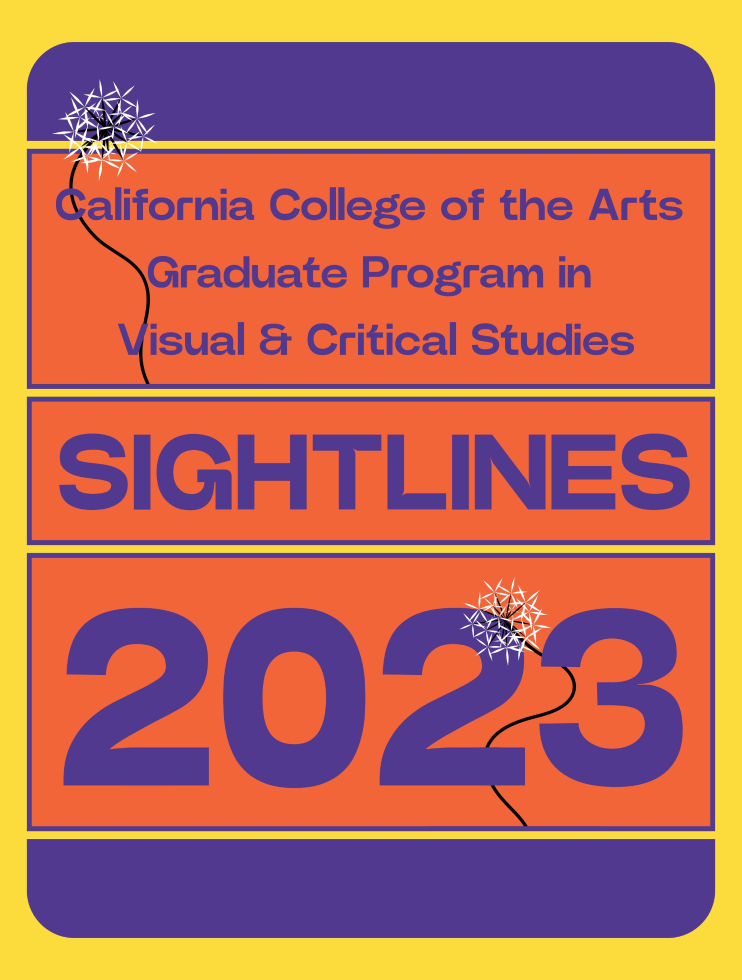
The art of making writing
The magazine Sightlines published by the graduate program in Visual and Critical Studies reveals how scholarly research combines with creative inquiry to uncover hidden stories or uneasy truths.

The graduate program in Visual and Critical Studies publishes students' research and writing in Sightlines.
At California College of the Arts, humanities and social science scholars and students study alongside emerging artists, designers, and architects, and their work is no less creative or imaginative.
Dean of Humanities and Sciences Jacqueline Francis says: “The humanities and social sciences are the study of human thinking and creativity—everything we do, our ideas, our stories, works of art come out of a curiosity of why we are here on Earth. What is our purpose?”
Francis is an art historian, curator, and creative writer who researches modern and contemporary U.S. art history. She is the author of Making Race: Modernism and “Racial Art” in America (2012), the first book-length study of interwar expressionist American painting, scrutinized through the lens of critical race art history.
She says, “I gravitate toward the untold stories, literally the ones in which there haven't been a lot of publications about—as in my PhD dissertation on the New York artist Malvin Gray Johnson. And at the same time, I also like to engage those untold stories with stories that are well known like Cubism or nineteenth-century Expressionism.”
For students and scholars, questions and individual research interests vary from person to person. “Three people can be looking at a set of phenomena—and come up with three different ways of writing about it,” says Francis.
Francis was previously the chair of the MA Visual and Critical Studies program which publishes graduate students’ research essays in an annual magazine called Sightlines. She points to Sightlines as an example of the kinds of creative research students engage in CCA’s Humanities and Sciences programs. The publication’s introduction affirms these students are “cultural producers who make writing.”
Rebecca Chacon (MA Visual and Critical Studies 2021), for instance, explored Frida Kahlo under the lens of disability studies, highlighting how past researchers have exploited Kahlo’s disabilities. “Her disabilities are either exaggerated or overlooked and fetishized because she created artwork that made her famous,” writes Chacon.
Chacon uncovers and contrasts the work Kahlo is well known for with her customized ankle boots (one features a significantly higher heel yet with fringe that deceptively conceals the height difference) which were found in 2004 at La Casa Azul. Chacon writes, “She was clear and intentional in her self-stylization—revealing her disability in art and concealing it in her boots and clothing. Kahlo’s boots and self-presentation enable a person-first analysis of Kahlo’s agency over her disabled body.”
In another piece from the same issue of Sightlines, Karl Daum (MA Visual and Critical Studies 2021), examines how 9/11 conspiracy memes combine disparate images and distinct events to create new political narratives. The meme Daum researched is called “Now Watch This Drive” in which video of United Flight 175 crashing into the World Trade Center’s South Tower is combined with footage of President George W. Bush golfing, and accompanied by the text, “Bush did 9/11.”
“The signs which comprise these memes no longer point to a verifiable reality,” Daum writes, illustrating how these two distinct images when combined create new meaning. “Instead, they assemble and reassemble into mobile narratives.”
This space where images and ideas collide online and where reality can be distorted, all while having an element of perceived truth, has wide implications. “Recall the months of false claims over election fraud from politicians and the media, the rise of QAnon’s death-cult meme symbology, and the riots and murders on January 6, 2021,” he writes.
And in a recent issue of Sightlines, Liz Godbey (MA Visual and Critical Studies and MFA Fine Arts 2023) interprets First Nations artist Christi Belcourt’s The Wisdom of the Universe (2014) in response to genre landscape painting and its colonizing gaze. She writes, “...Belcourt’s beadwork painting exists in conversation with Euro-American landscape painting. Her work disrupts colonial discourses on landscape, notions of the sublime, and the exaltation of the disembodied or disconnected eye.”
Godbey highlights historians and researchers who have traced how Western botany and the Western Art canon have framed the natural environment as a resource to extract under European expansion and imperialism.
“Belcourt’s work depicts an enchanted world—a world that refused to be disenchanted, to be mechanized and separated,” Godbey writes.
CCA Visual and Critical Studies scholars like those featured in Sightlines engage with and reframe or reinterpret ideas with new questions they want answered. Francis says, “The study of art is the study of ideas—even if it’s not readily apparent that those ideas are philosophy or history.”


